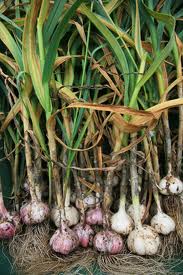Brief Description:
Garlic is a
glabrous, bulbous, herb which grows to the height of about 30cms. The leaves
are flat, narrow and long. The bulb consists of numerous bulblets known as
cloves, enclosed with in a whitish skin. It is a well known herb in the garden.
It is grown for culinary and medicinal use.
Medicinal Use:
·
Used to kill or expel worms from the body.
·
Prevents or cures spasms.
·
Stimulates flow of saliva, helps in digestion, and
relieves flatulence and griping pains from stomach and bowels.
·
Promotes the flow of urine.
·
Promotes the removal of mucous secretions from
the bronchial tubes.
·
Used to reduce or eliminate fevers.
·
Promotes the dissipation of a growth or
swelling.
·
Can be used in chronic bronchitis, tuberculosis,
pneumonia, asthma, and other respiratory ailments.
·
It is an excellent medicine for colds and can be
used in case of sore throat, hoarseness and tonsillitis.
·
Best remedy for hypertension.
·
Acts as natural antibiotics and prevents cancer.
·
Good remedy for earache, deafness and the delay
of the graying of the hair.
·
Helps to remove Gastritis from the body.
·
It is also good for various skin problems.
·
Scientific students have proved that the
consumption of garlic reduces the cholesterol level in the body.
·
Used to bring down the pressure
How to Use:

- Use of
raw garlic in salads is one of the best remedies for hypertension.
- The
decoction of garlic mixed with coconut oil is given for worms and in
smaller doses it is good for infection of the sciatic nerve, inflammation
of the respiratory tract and hysteria.
- The
tea of garlic sweetened with honey is recommended as a poultice for
ringworms.
- Raw
garlic juice is good for whooping cough and pulmonary consumption or
tuberculosis. Diluted in water the garlic juice is good for earache,
corns, fungal infections of the skin and skin spots, etc.
- A
crushed clove of garlic heated in a tiny vessel or tablespoon containing
coconut oil or mustard oil can be very effectively used for earaches. Only
the mild warm (Luke warm) should be put into the painful ear.
- The
water obtained after simmering of the finely chopped garlic can eliminate
the gastritis. Remember, the finely chopped garlic should be simmered for
more than 12 hours. Drink a glass of the obtained water daily in the
morning by mildly heating before you eat or drink anything. Do not drink
or eat anything for an hour of drinking the decoction (the obtained water
after simmering)
Parts Used:
- The
bulbs (as food, the whole plant can be used)
Dose:
Caution: Those who suffer from hypotension (low blood
pressure) should not use garlic.
 Aloe is used for both ornamental as well as medicinal purpose. It is
short stemmed and the spiny-toothed leaves are very succulent or juicy. The
drooping flowers are yellow in color. When the plant is mature,, from the
middle an erect stalk grows which is a meter in height. The fruit is an oval
capsule containing numerous seeds.
Aloe is used for both ornamental as well as medicinal purpose. It is
short stemmed and the spiny-toothed leaves are very succulent or juicy. The
drooping flowers are yellow in color. When the plant is mature,, from the
middle an erect stalk grows which is a meter in height. The fruit is an oval
capsule containing numerous seeds. 













